Expression of AFP and Rev-Erb A/Rev-Erb B and N-CoR in fetal rat liver, liver injury and liver regeneration
- PMID: 16822301
- PMCID: PMC1552085
- DOI: 10.1186/1476-5926-5-2
Expression of AFP and Rev-Erb A/Rev-Erb B and N-CoR in fetal rat liver, liver injury and liver regeneration
Abstract
Background: Alpha-fetoprotein (AFP) expression can resume in the adult liver under pathophysiological conditions. Orphan nuclear receptors were supposed to regulate AFP gene expression, in vitro. We were interested to study the expression of AFP and orphan nuclear receptors, in vivo.
Results: The expression of AFP gene and orphan nuclear receptors in the liver was examined in different rat models: (a) fetal liver (b) liver regeneration [partial hepatectomy (PH) with and without 2-acetyl-aminofluren treatment (2-AAF)], (c) acute liver damage [treatment with CCl4] and (d) acute phase reaction [treatment with turpentine oil]. After PH of 2-AAF treated rats, clusters of AFP positive cells occurred in the periportal region. In the Northern blot analysis, a positive hybridization signal for the full-length AFP-RNA was observed only in liver samples from 2-AAF treated rats after PH. In real-time PCR analysis, the full-length AFP-RNA was highly up regulated in the fetal liver (maximum at day 14: 21,500 fold); after PH of 2-AAF treated rats, the full-length AFP-RNA was also up regulated up to 400 fold (day 7 after PH). The orphan nuclear receptors were down regulated at nearly each time points in all models, also at time point of up regulation of the AFP gene.
Conclusion: Expression of "fetal" AFP could be demonstrated during liver development and during proliferation of the so-called oval cells. Changes of expression of orphan nuclear receptors, however, did not correlate with AFP expression. Other regulatory pathways were possibly involved in controlling AFP expression, in vivo.
Figures

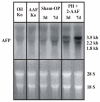
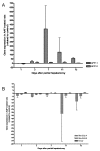

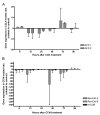
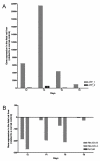
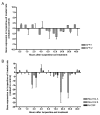
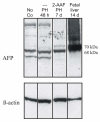
References
-
- Evarts RP, Nagy P, Marsden E, Thorgeirsson SS. A precursor-product relationship exists between oval cells and hepatocytes in rat liver. Carcinogenesis. 1987;8:1737–1740. - PubMed
-
- Kuhlmann WD. Localization of alpha1-fetoprotein and DNA-synthesis in liver cell populations during experimental hepatocarcinogenesis in rats. Int J Cancer. 1978;21:368–380. - PubMed
-
- Bernier D, Thomassin H, Allard D, Guertin M, Hamel D, Blaquiere M, Beauchemin M, LaRue H, Estable-Puig M, Belanger L. Functional analysis of developmentally regulated chromatin-hypersensitive domains carrying the alpha 1-fetoprotein gene promoter and the albumin/alpha 1-fetoprotein intergenic enhancer. Mol Cell Biol. 1993;13:1619–1633. - PMC - PubMed
LinkOut - more resources
Full Text Sources
Molecular Biology Databases
Research Materials
